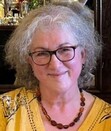Debbie Young's Blog, page 2
June 30, 2025
In Conversation with Author Helen Hollick about Ghosts, Fate and Mysteries
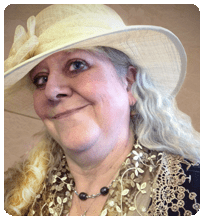 Meet the unstoppable Helen Hollick
Meet the unstoppable Helen HollickWhen earlier in the year, I scheduled this interview with my author chum Helen Hollick, it was going to be on the topic of ghosts, following the publication of her latest non-fiction book, Ghost Encounters: The Lingering Spirits in North Devon. Since then, she’s published another book, the ten-author anthology Fate, and is just about to launch A Mischief of Murder, the latest installment in her Jan Christopher cosy mystery series. Her productivity and her passion for what she writes are limitless – even when little things like her daughter’s wedding and her hip replacement crop up along the way!
Debbie: Helen, although you’ve included elements of the supernatural in your Jesamiah Acorne series of piratical adventures. Ghost Encounters: The Lingering Spirits in North Devon is a new departure for you, Have you always believed in ghosts?
Helen: I’ve never not believed, but I became more, let’s say ‘curious’, towards the end of the 1900s.
I was exploring the battle site at Battle, Sussex, walking down the hill in the rain when I suddenly felt the hairs on my neck stand up and an enormous sense of ‘presence’ behind me. I just knew that if I turned round I’d see King Harold’s shield wall of soldiers in front of the present Abbey.
I didn’t have enough courage to look though, so I’ll never know… but soon after I decided to write my novel, Harold The King and we went back to the site as a family several years running for the annal re–enactment days in October. Every time, my daughter ‘saw’ things that others couldn’t. It dawned on me that she could see the dead.
When we moved to our eighteenth-century Devon farmhouse, her gift became even more obvious, for she could clearly see and speak to our former ‘residents’, and others around the village and local area. I regard her ability as something quite natural and not at all scary. In fact most ‘ghosts’ are perfectly friendly – much of the ‘uncanny’ stuff on TV is over-dramatised nonsense.
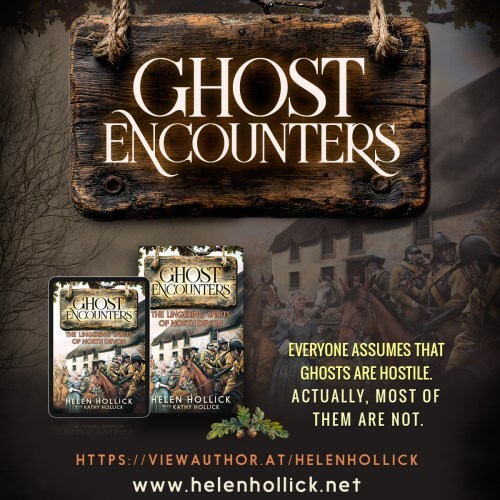
Debbie: You’ve focused on a relatively small geographical area in this book. What is it about the area that makes it particularly rich with ghosts?
Helen: It’s purely a matter of logistics: North Devon is where I and my family live, so it made sense to write about ‘our’ ghosts! I wanted to write about our ‘extended family’, and the ghosts that can be encountered (if you’re that way gifted) in our village pub.
Originally, I was commissioned by a well-known non-fiction publisher to write the book as part of their Ghosts of England series. Despite sending them a detailed synopsis and several draft chapters, they rejected the finished book because it was ‘too personal’. They wanted me to cut out all Kathy’s encounters – which would have changed the point of the entire book. So I cancelled the contract and self-published it myself.
Debbie: You co-authored this book with your daughter Kathy. What role did she play in its research and writing?
Helen: Kathy is severely dyslexic, so reading and writing is not easy for her, (although thank goodness for technology and a laptop!) I did the actual writing, and Kathy did all the ‘supernatural’ work, relating to me who and what she encountered, and where. Between us we added a few third-party anecdotes gleaned from people willing to share their experiences. It’s surprising how many people are reluctant to share their encounters, though.
For instance, while in Barnstaple car park one afternoon, Kathy pointed up at the Norman motte-and-bailey ‘castle’ and informed me: “There are three Normans aiming crossbows at us.”
Another time she shouted at the driver of our car to “Mind that man!”
“What man?”
“The man in high-vis yellows walking down the middle of the road… there … that man!”
A car coming the other way didn’t swerve either. Not that it mattered, High-vis Man had already vanished.
Kathy regularly chats to our house residents – and they all came along to Kathy’s recent wedding!
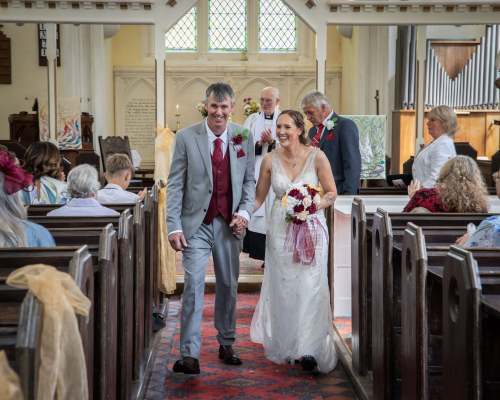 See the empty pew on the right at Kathy’s wedding? Apparently it’s not really empty…
See the empty pew on the right at Kathy’s wedding? Apparently it’s not really empty…Debbie: What is your response to sceptics who don’t believe in ghosts and seek to explain everything scientifically?
Helen: Fair enough to not believe, but not being able to prove something doesn’t mean it doesn’t exist. Several years ago no-one could prove Black Holes existed – scientists cannot prove String Theory or Dark Matter.
When talking to a genuine medium, however, it’s hard not to believe. A genuine medium, by the way, is aware of ghosts/spirits (whatever term you prefer) at any time of day or night, and only needs to say “hello”, not “Is there anyone there?” As I said earlier, much of the uncanny stuff broadcast on TV is intentionally designed to scare and entertain. (Why do people like horror and scary things? I don’t!)
Seances and “knock once for yes” etc is a remnant from the Victorian age of pseudo-science – and might be fun, but is only clever trickery.
Debbie: I’ve never seen any ghosts, although I know people who have. But I do have a vivid memory of having to literally run out of the army museum in Paris many years ago, because I was suddenly overwhelmed by the display of hundreds, possibly thousands, of swords and guns, and the thought of how many deaths there were responsible for. Would you say that might have been caused by lingering spirits, or simply by my vivid imagination and extreme sensitivity to violence? Whatever the reason, I know I’ll visit Pompeii or Herculaneum, much as I’d love to, as I’d be too distressed by thoughts of so unfortunate victims of Vesuvius now uncovered by archaeologists.
Helen: I’ve never seen a ghost either – but as I mentioned above at Battle Abbey I’ve felt something supernaturally awesome. I think many of us do when entering certain sites – old churches for instance. That feeling of something…? I’d say your reaction is sensitive empathy – genuinely aware of the horror of battle, possibly fed by imagination. It’s what makes us good writers, after all!
But the fear of ghosts has been ‘groomed’ into us, mostly by religions which saw anything unexplainable as the devil’s work or presence. Yet those who were later seen as saints seem to have been believed about spiritual presences or voices. Let’s face it, the most famous ‘ghost’ is the Holy Spirit!
Halloween and the persistence of spooks and nasty hauntings has perpetuated our common fear. But most of the spirits which linger among us are perfectly benign, and are probably as unaware of us as most of us are of them. Graveyards, by the way, have very few ghosts, because these residents really do ‘rest in peace’. Some newly passed-over spirits might be hostile because they are confused and bewildered, uncertain what has happened and are in a state of shock. A genuine medium, (and I include Kathy here) can sensitively, quietly and calmly move them on to where they should be.
Are there ghosts at Pompeii and Herculaneum? Possibly, probably, but I doubt any of them are hostile or intent on malicious haunting. Any who are still there are very probably as intrigued by us, as we are of them, so there is nothing to be frightened of.
Debbie: Apart from your experience at Battle, has there been any other inciting incident that prompted you to believe in ghosts?
Helen: One puzzling thing has stayed with me… not exactly a ghost, but a very vivid dream, which I describe in Ghost Encounters. I dreamt of a Great Western steam engine coming too fast into a station. The locomotive was much bigger than myself, so I had the impression that I was a child. I could clearly hear all the alarming sounds and saw the loco’s name and number. I woke up and wrote both down, then later on Googled for it – to discover this was a genuine Great Western locomotive Torrington 34031. Now, I like steam trains, but the only ones I actually know are Mallard and the Flying Scotsman. Was this a dream, a past life memory… or what?
Debbie: Wow! That’s pretty uncanny. So, how should people behave when first encountering the kind of vision you describe in your book?
Helen: If you do meet a ghost, take a deep breath, keep calm, smile and say hello. And remember that ghosts are not like the stars or false teeth, they don’t only come out at night! And they dislike cold, dark, damp cellars as much as we do!
Debbie: You whet readers’ appetites for ghost fiction with two short stories included as a bonus feature at the back of Ghost Encounters, but it seems that wasn’t enough to satisfy your interest in the supernatural, because you’ve gone on to create a new multi-author anthology, Fate: Tales of History, Mystery, and Magic. Among its ten stories by different authors, your contribution is another ghost story, and there are supernatural elements in other stories too. Can you please tell us a little more about your vision for this anthology, and how it has turned out?
Helen: I wrote “In The Shadow Of Ghosts” after I’d published Ghost Encounters, but had no idea what to do with my story, which is based around some English Civil War ghosts that linger in our village pub. (I wrote the story because I wondered how and why they were there in the first place!) “I know,” I thought, “what about doing another anthology?” Most of my writer friends pen historical novels, mysteries or fantasy, so the general theme was an easy one to come up with: history, mystery and magic.
Although I say so myself, I think this anthology is an absolute cracker!
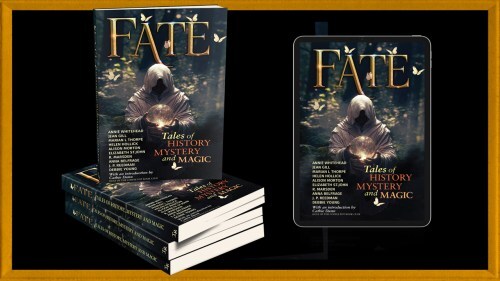 (Promotional image by Jean Gill, contributing author to “Fate”)
(Promotional image by Jean Gill, contributing author to “Fate”)Debbie: Thank you so much for inviting me to be one of the anthology’s contributors, Helen. I was so pleased to have this prompt to write a suitable story set in the world of my Sophie Sayers cosy mystery novels, “Saints Alive”, in which young Sina has a close encounter with St Bride, the patron saint of the ancient Cotswold parish church in her village of Wendlebury Barrow.
And speaking of cosy mystery set in the English countryside, you’re now about to launch a new book in your own cosy mystery series, featuring Jan Christopher, inspired by your former career as a librarian on your former home turf of North-East London on the borders of Essex. Young Jan comes to spend a lot of time in North Devon as it’s home to her fiancée, a young detective, and together they solve murder mysteries both in the London Borough and in Devon. This new novel is based around an event dear to my heart: the annual village fruit and vegetable show! Can you please tell us a little more about it?
We have an annual show here in Chittlehamholt and I thoroughly enjoy entering various items – flowers mostly, as I’m not a very good veg grower. But I did win with my damson gin the other year, and have been successful with the creative exhibit class. One year I won with ‘an exhibit based on a film’ – I did “Pirates of the Caribbean” (naturally!). Another year I won with ‘based on a book title’ my entry was “Cider With Rosie.” And in 2023 I came 1st with an exhibit depicting the coronation.
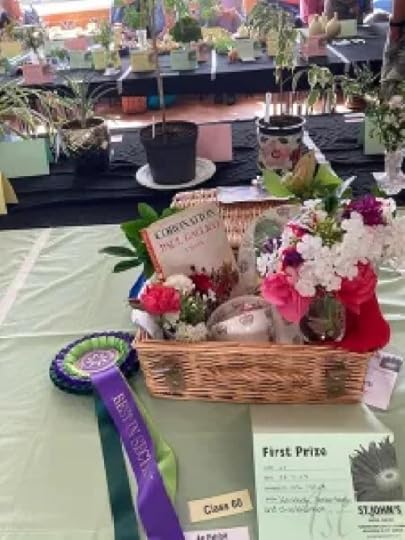 First prize to Helen Hollick at Chittlehamholt Village Show!
First prize to Helen Hollick at Chittlehamholt Village Show!This year (2025) the theme is “A Jane Austen Novel”. Except I can’t tell you what my entry will be as it’s still secret!
I decided to use the village show idea as my next Jan Christopher mystery because there’d been quite a bit of teasing about the hanging baskets entries between my husband and one of our village friends, and, of course, someone had mentioned about all the shenanigans that go on behind the scenes with attempts at cheating – or making mischief. I had great fun writing this sixth episode!
A Mischief of Murder is available for pre-order here and will be launched on Tuesday 16th July.
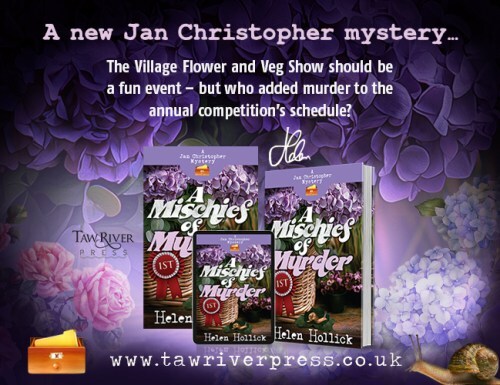 Now available to pre-order – launching on 16th July
Now available to pre-order – launching on 16th JulyDebbie: Where I live in the Cotswolds, our Hawkesbury Show is the longest continually running one in the country and the highlight of the community’s year, so I’ll especially enjoy A Mischief of Murder! Finally, Helen, when you’ve had such a busy year so far, I hardly dare ask this question – but what will you write next?!
Helen: I’ve already started Jan Christopher Episode 7, A Matter of Murder. This one takes place in Hertfordshire at a place called Dobbs Weir, a tributary of the River Lee, and involves a sailing dinghy, a gypsy caravan, a swan or two … oh, and a mystery to solve. It’ll be out either later in 2025 or early 2026, depending on how fast I can write it! And then there will be Episode 8 … and another in my “Sea Witch Voyages” series. And perhaps another anthology?
Debbie: Helen, thank you so much for taking time out from your intensive schedule to update us on your three latest books. I don’t know how you do it!
About Helen Hollick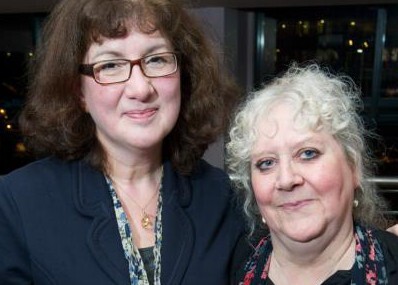 Helen and I go back a long way! Here we are at my first book launch, which appropriately enough seems like ancient history now!
Helen and I go back a long way! Here we are at my first book launch, which appropriately enough seems like ancient history now!Known for her captivating storytelling and rich attention to historical detail, Helen’s historical fiction, nautical adventure series, cosy mysteries, and short stories, skilfully invite readers to step into worlds where the boundaries between fact and fiction blend together.
Helen started writing as a teenager, but after discovering a passion for history, was initially published in 1993 in the UK with her Arthurian Pendragon’s Banner Trilogy and two Anglo-Saxon novels about the events that led to the 1066 Battle of Hastings, one of which, The Forever Queen (USA title – A Hollow Crown in the UK) became a USA Today bestseller. Her Sea Witch Voyages are nautical-based adventures inspired by the Golden Age of Piracy. She also writes the Jan Christopher cosy mystery series set during the 1970s, and based around her, sometimes hilarious, years of working as a North London library assistant. Her recent release, Ghost Encounters, is a non-fiction book about the ghosts of North Devon – even if you don’t believe in ghosts you might enjoy the snippets of interesting history and the many location photograhs..
Helen and her family moved from London to Devon after a National Lottery win on the opening night of the 2012 London Olympics. She spends her time glowering at the overgrown garden, fending off the geese, chasing the peacocks away from her roses, helping with the horses and wishing the friendly, resident ghosts would occasionally help with the housework…
Website: https://helenhollick.net/
Amazon Author Page: https://viewauthor.at/HelenHollick
Facebook: https://www.facebook.com/helen.hollick
Bluesky: @helenhollick.bsky.social
X/Twitter @HelenHollick https://x.com/HelenHollick
Blog: supporting authors & their books https://ofhistoryandkings.blogspot.com/
Monthly newsletter : Thoughts from a Devonshire Farmhouse
June 26, 2025
In Tune with My Piano
I always enjoy my piano tuner’s annual visit. No matter how much dust has gathered on my bookshelves, or how much laundry is piling up in my utility room, I know he’ll restore at least this one small corner of my house to perfect order.
I’m intrigued by how many tiny adjustments he needs to make. I like to think I’m sufficiently musical to recognise which notes have gone awry, but any slippage of the strings takes place in such tiny increments that I don’t notice them as they happen.
It’s analogous to not noticing how much my nails grow. It may seem only five minutes since I last trimmed them into shape, then overnight they turn into talons.
For the piano tuner witnessing a year’s worth of changes at a glance, it must be like doing a spot-the-difference puzzle. His task is to pick out the details that need adjusting to restore the instrument to how it was when he left it twelve months before.
While he’s at work, I leave the room, pretending not to listen, yet fascinated by the numerous tiny adjustments. I only return once he’s played one of his party pieces to test the net result. This time, it’s a bit of Grieg’s “Peer Gynt”. Then I watch him replace the front panels he’s removed to access the instrument’s inner workings.
Only after closing the lid does he realise he’s lost his glasses – the equivalent to a surgeon realizing a probe is missing only after stitching up a patient.
Fortunately, he finds them on the floor, where he’d been inspecting the pedals.
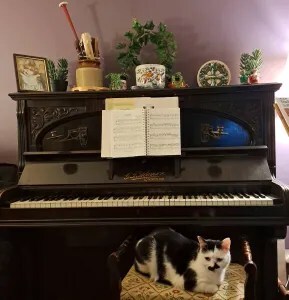 It could have been worse – at least no cats were trapped inside the piano
It could have been worse – at least no cats were trapped inside the pianoWhen he’s gone, I run my fingers across the keys with renewed appreciation of the piano’s aesthetics. No matter how muddled the rest of my house as I scurry about my busy daily life, my piano will only ever look neat and tidy. I’ll never come down one morning to find all the black keys have pooled at one end, or that the white notes have fallen on the floor, waiting like lost Lego bricks to pain the soles of my feet.
If only all aspects of my life were as easy to reset as my piano. Then I might even find time to play it.
(This post was first published in the June 2025 edition of the Tetbury Advertiser.)
(If you like stories about piano tuners, check out “Perfect Harmony”, one of 20 flash fiction stories in my collection, Quick Change, which I’ve just realised I first published 10 years ago. Where did that decade go?! It’s still available in ebook and paperback.)
IN OTHER NEWSSaints Alive – It’s a New Sophie Sayers Story!
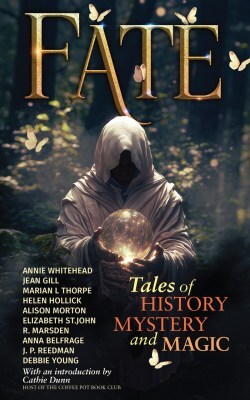 Home to a new Sophie Sayers short story
Home to a new Sophie Sayers short storyAs you may know, I love writing short stories set in the world of Sophie Sayers, the central character in one of my series of cosy mystery novels, (first in series is Best Murder in Show). So I was delighted when my author friend Helen Hollick invited me to contribute to a new anthology she was compiling on the theme of fate. Although Helen is primarily a historical novelist, she adores Sophie Sayers, and says my novels about her inspired her to write her own cosy mystery series about young librarian Jan Christopher (first in series A Mystery of Murder).
Given that the other nine contributing authors are historical novelists (although some write contemporary fiction too), I decided to write a story with a historical twist, focusing on the saint that gave Sophie’s parish church its name: St Bride. “Saints Alive”, written especially for this anthology, includes Sophie and many of her Wendlebury Barrow friends and neighbours featured in my novels. This time, Tommy’s wily little sister, Sina, takes centre stage, in a mysterious encounter in the parish church. I was pleased that Helen placed my story at the end of the anthology, as it provides an upbeat, happy ending to an anthology that subjects the reader to a gamut of emotions.
Just launched, Fate is starting to gather some super reviews, such as the following on Amazon:
Excellent writing that drew me right into every story. Not a dud amongst them. – Highlander, via Amazon
This delightful collection of stories takes us on a journey through time (in one case quite literally), and into the realms of magic and mythology. The reimagining of events and legends creates a riveting collection of stories that are both connected by theme and also very diverse in style and content. At the heart of them all is a sense of fate, of things ordained, of serendipitous encounters. Each story is so different but somehow the anthology hangs together beautifully. It is hard to chose a favourite and each one left me wanting more! Happily, each author represented has a body of published work that is there to be discovered. I highly recommend this anthology and hope there may be a second volume. Who knows what the fates will decree! – Lew, via Amazon
These stories are exclusive to this anthology, so you won’t be able to read them anywhere else! Available in paperback and ebook, Fate could be just what you’re looking for to read on your summer holidays.
Now I must dash – I’m off to interview Helen Hollick for my next blog post, when she’ll be telling me all about her new non-fiction book, Ghost Encounters: The Lingering Spirits of North Devon, co-authored with her daughter Kathy, who has had fateful close encounters at first hand!
June 11, 2025
Off the Shelf
The Japanese have a word for it: tsundoku*.
That is, buying more books, even though you haven’t read all those you have at home. To Western ears, that term may sound like criticism, but in the Far East it’s regarded as reasonable.
I’m clearly living in the wrong country. Despite being a speedy reader, I buy books faster than I read them. My to-read list never stops growing.
Compounding the problem is my delight in rereading old favourites. I often choose old over new.
Rereading a familiar book is like watching repeats on television. We do it because we know we’ll enjoy them. Even if we have a nagging feeling that we’re squandering time, we’re not. They make us happy.Every time we reread a book, we notice details we missed on first reading. This is particularly true in crime writing, where we spot red herrings that fooled us before, or in any fiction featuring unreliable narrators whom we originally trusted.Our experience of a book also changes at each reading because we have changed as people. We’re not the same person at each encounter. The longer we leave it, the more our perspective may alter. Different factors resonate with us every time.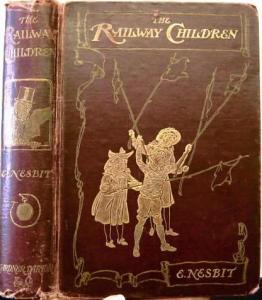 A first edition copy https://en.wikipedia.org/wiki/The_Railway_Children
A first edition copy https://en.wikipedia.org/wiki/The_Railway_ChildrenAn extreme example is rereading children’s books, which I often do. Revisiting E Nesbit’s The Railway Children last year, I identify now with the children’s mother.
As a child, I empathised with Phyllis. As the youngest of three siblings, my sympathies naturally gravitated towards the smallest child in stories. Having recently read the author’s biography added fresh insights into her fiction.
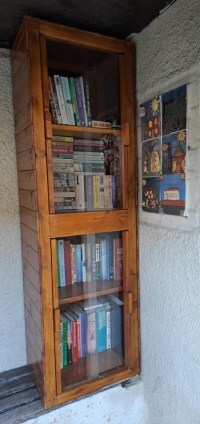 The new Books on the Bus Little Free Library bookcase, made by my husband
The new Books on the Bus Little Free Library bookcase, made by my husbandEven when we buy books with the best intentions, sometimes we grow out of them before we can find time to read them. There’s no shame in disposing of books you’re never likely to read, and there’s no shortage of good homes for them. Look no further than the bus stop in Hawkesbury Upton High Street, where a new, larger shelf unit built by my husband is about to be installed, thanks to the Parish Council’s kind grant for materials.
How many books are too many to have in your home?
In her debut self-help book, Japanese decluttering guru Marie Kondo recommended owning no more than 30. Never hesitate to part with books, she advised, because in the age of the internet, if you change your mind, it’s easy to track down a replacement.
At least, that’s what I think she said. I can’t check, because, I confess, my copy of The Life-Changing Magic of Tidying has long since left the building. The Japanese have a word for that too. I I just looked it up online. It’s 皮肉.* Pronounced: ai-ron-i.
*The Japanese characters making up this word literally mean “skin-meat”, but its meaning as well as its pronunciation is the same as our irony.
(This article first appeared in the June 2025 edition of the Hawkesbury Parish News.)
IN OTHER NEWS
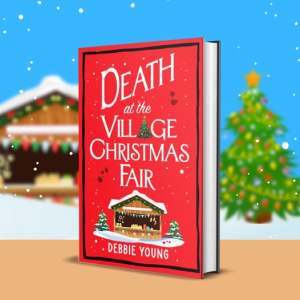
Behold – the official unveiling of my next book, Death at the Village Christmas Fair, which will be launched on 16th August, in plenty of time for Christmas. I had great fun writing this one, with the suspect playing hard-to-get in a Santa Run, in which everyone is dressed as you-know-who! It also gave me lots of opportunities to write about knitting, one of my favourite hobbies. Yes, there is a connection between the Santa Run and knitting – but you’ll have to read it to find out what it is!
This is third book in the Cotswold Curiosity Shop series, the first two being Death at the Old Curiosity Shop and Death at the Village Chess Club. Both of these have been Amazon Bestsellers, so I’m crossing my fingers for this one to join that heady status.
In the meantime, I’m wondering what to write next – another adventure in one of my series (the others are the Sophie Sayers and Gemma Lamb cosy mysteries), a new stand-alone story, or a novelisation of my first play, which debuted in April, The Importance of Being Murdered.
My involvement with the Badminton Benefice Festival of Music (see previous post) is also making me hanker after writing a series of mysteries in musical settings.
I’m sending several outlines to my publisher, Boldwood Books, for them to choose. If you have a preference, do tell me, and I’ll pass it on to Boldwood. I’ll be sure to let you know what they decide.
June 6, 2025
Inspired by the Badminton Benefice Festival of Music
“If you want something done, ask a busy person.”
That may be one reason that I’ve found myself helping behind the scenes with a wonderful new music event founded by Badminton Benefice Music Director Ben Humphries. Badminton Benefice – part of the Diocese of Gloucester – contains ten ancient and beautiful rural churches, each in an idyllic, timeless setting. Sharing one vicar between them, the Reverend Richard Thomson, there is a limit to how many church services they can host each month.
One of the aims of the Festival is to provide occasions for more people to visit the churches and to enjoy these historically significant settings which are such a rich part of our local heritage. The other aim is to create live, accessible music events to the local community. All of the events are free to attend, but donations towards the maintenance of the churches and to the music charity Youth Music, which gives young people the chance to transform their lives through the power of music.
Each event will be different, resulting in a glorious mixture of musical offerings, some with art and/or flowers, and always refreshments, to be held on Sunday afternoons, one each month, from May to September. The event poster provides a handy summary of the programme:
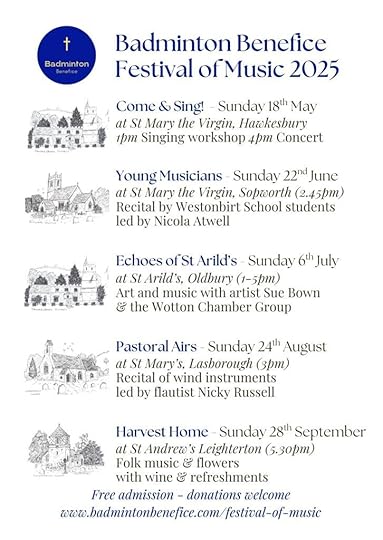
The charming line drawings of each church are by Gillian Dawson, a former member of Hawkesbury Choir.
My role in the Festival has been as part of a small team behind the scenes, helping to raise awareness of the concert series and to attract an audience. I sang in the first event, which took place last month at my home church of St Mary’s, Hawkesbury.
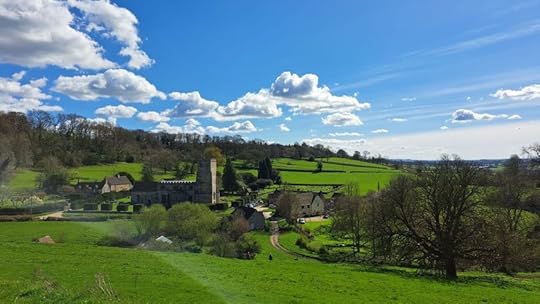 The Church of St Mary the Virgin, photographed in its gorgeous ancient rural setting one Easter Sunday, viewed from Hawkesbury Knoll
The Church of St Mary the Virgin, photographed in its gorgeous ancient rural setting one Easter Sunday, viewed from Hawkesbury KnollThe Come & Sing! event, directed by the brilliant singing teacher Amy Garry of Voices Together, also inspired me to write the following article for the May issue of the Hawkesbury Parish News. Even though the event has happened now, I thought you might still like to read it.
For the Love of SingingOne of the highlights of primary school for me was the daily assembly, in which we’d all sing together in the school hall.
Days Lane Primary School, in Sidcup, Kent, was actually two schools in one, a single-storey brick quadrangle built in the 1920s. The infants were in one half, the juniors in the other, each with their own school hall and head teacher.
The daily assembly included two hymns from the pale blue Songs of Praise book and a few thoughtful words to inspire us. Every Tuesday, the Juniors stayed on after assembly while the teachers went back to their classroom (or maybe to drink coffee and smoke in the staffroom), leaving our jovial headmaster, Mr Bowering, to lead the whole school in hymn practice. From his lectern on the stage, accompanied by a pianist, he taught us new hymns. He also insisted on a rousing weekly rendition of ‘Jerusalem’. I still remember the words and numbers of my favourite hymns.
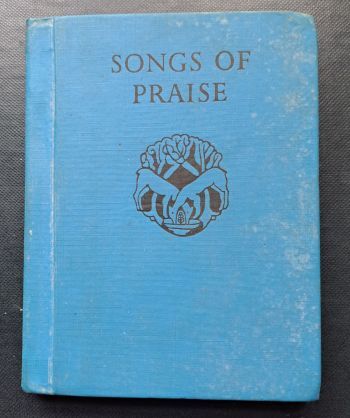 The Songs of Praise hymnbook – the soundtrack for my childhood
The Songs of Praise hymnbook – the soundtrack for my childhoodI loved this vibrant act of community – the only occasion that all the pupils were engaged in the same activity. How Mr Bowering must have enjoyed conducting our singing in one roof-raising voice as we gazed up at him.
I also loved the sense of place. A simple map of the globe hung above the stage, making us feel like citizens of the world. Tiny lightbulbs picked out the capital cities of the most important countries. Mr Bowering controlled them from a box of switches beneath his lectern. When he lit up a city, we’d have to shout its name.
I miss those Tuesday mornings. That’s one reason I joined Hawkesbury Choir. Like those school hymn practices, weekly choir practices have become an important fixture in my calendar. I count them as an act of self-care, good for my well-being mentally and physically. I even managed to persuade my GP they count as exercise. (He gave me another tick for bell ringing practice.) I’ve been lucky enough to sing with Hawkesbury Choir not only in our own ancient parish church, but also in the beautiful parish churches of Badminton, Cirencester, Didmarton, and Leighterton.
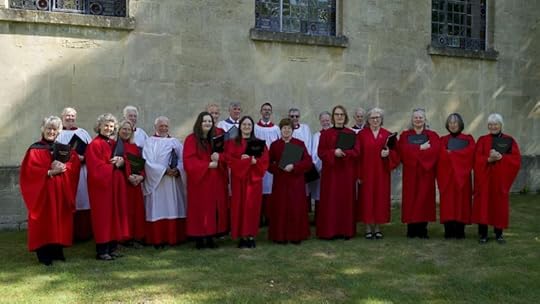 Hawkesbury Choir with guest singers after singing at the Badminton Horse Trials Morning Prayer service earlier this year (I’m fourth from the right)
Hawkesbury Choir with guest singers after singing at the Badminton Horse Trials Morning Prayer service earlier this year (I’m fourth from the right)While community singing can make everyone feel better, hymns aren’t everyone’s cup of tea. So, it’s great news that a fun, free, secular singing event, COME & SING, will take place on Sunday 18th May at St Mary’s Hawkesbury, and it’s open to all ages from 9 to 109. Although it’ll take place in the church, we’ll be singing popular contemporary music rather than hymns. Think ‘Mamma Mia’ rather than ‘Ave Maria’, although I can’t promise Abba will be on the agenda.
From 1pm, there’ll be a singing workshop led by professional singing teacher Amy Garry of Voices Together, accompanied by Ben Humphries, Badminton Benefice Music Director.At 4pm, the singers will perform an informal concert for anyone who cares to attend. Light refreshments will be provided.All of this is free of charge, although donations will be welcome. Any profit will be shared between St Mary’s PCC and the music charity Youth Music.
To join the workshop, please register at badmintonbenefice.com.To attend the concert, no booking is necessary – just turn up.COME & SING! is the first in a series of musical events in the new Badminton Benefice Festival of Music to be held this summer in churches throughout the Benefice. All of the events will be free to attend, apart from the grand finale at Great Badminton in November featuring the newly restored organ. More information and dates will be shared on the Benefice website as details are confirmed.
In the meantime, you know what to do… COME & SING!
(This article first appeared in the May 2025 issue of the Hawkesbury Parish News.)
NEXT EVENT IN THE BADMINTON BENEFICE FESTIVAL OF MUSIC: Young Musicians at St Mary the Virgin, Sopworth on Sunday 22nd JuneWhile it’s too late for you to join in the COME & SING! event described above, if you’re within striking distance of the Badminton Benefice, you might like to come along to our June event, an uplifting recital by students of Westonbirt School at Sopworth’s Church of St Mary the Virgin. (In all, five of the Benefice churches are St Mary’s!) It will take place on Sunday 22nd June, starting at 2.45pm. Yes, that is an unusual starting time, but it’s carefully chosen to fit in between the students’ Sundy lunch and their rehearsals later in the day for the school’s annual musical production! 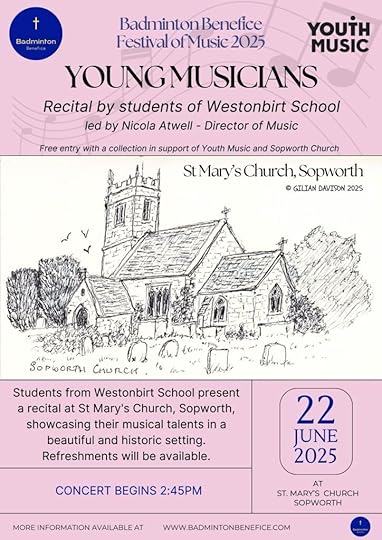
For more information about the Badminton Benefice Music Festival, visit its website page at www.badmintonbenefice.om/festival-of-music
IN OTHER NEWS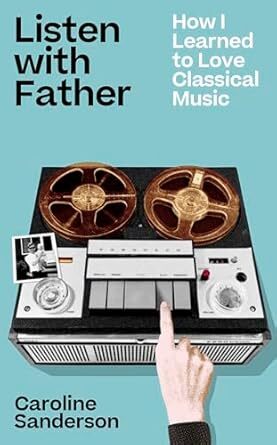 To be published on 3rd July by Unbound
To be published on 3rd July by UnboundYesterday I met my friend Caroline Sanderson, author and books journalist, for lunch, and I was delighted to hear all about her plans for the launch of her new book, which is on a musical theme.
The title, Listen with Father, is a nod towards those of us old enough to remember the daily children’s BBC Radio programme, Listen with Mother, heralded each week by the delightful theme tune, the Berceuse from Fauré’s “Dolly Suite“. However, the subtitle, How I Learned to Love Classical Music, alludes to Caroline’s father’s legacy – a lasting love ot the classics. Caroline’s publisher, Unbound, describes her book as follows:
Listen with Father is a book about the transformative power of listening, and about how we remember those we have loved and lost.
At four years old, Caroline Sanderson fell in love with the music of Mozart after listening to it with her father. At eight, she fell even harder for the songs of David Bowie. Her dad made many gentle attempts to persuade her back to his world of classical music, but it wasn’t until after he died that she returned to it, in memory of him.
In a beguiling blend of memoir and biography, we follow Sanderson as she set out to listen, with great care and attention, to the music her dad loved, to work out why he so appreciated it and whether she could too. From hearing Mozart recitals in Salzburg to visiting Sibelius’s house near Helsinki and playing Robert Schumann at home on the piano, this is a beautifully touching and absorbing story of a beloved father, told through the classical music he cherished.
Order your copy in paperback or ebook from the publisher’s website here.
Meanwhile, there is lots of pending news about my books, but some of it’s embargoed until next week, so watch this space!
May 28, 2025
In Conversation with Author Howard Lovy
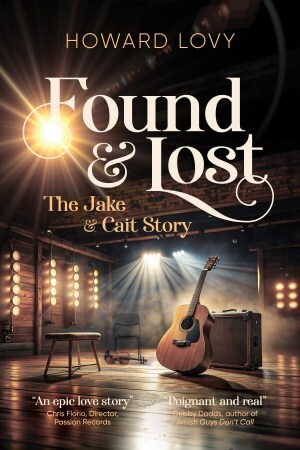 I’ve known Howard Lovy, American journalist, podcaster, and editor for eons, through our work for the Alliance of Independent Authors. I was surprised and delighted for him when he told me he was also about to become a published author. His debut novel, Found and Lost: Jake and Cait’s Story, was published by Vine Leaves Press, run by another longstanding author friend of mine, Jessica Bell. As Howard’s novel focuses around the music industry, and the multi-talented Jessica is also a singer/songwriter, I knew the story would be good.
I’ve known Howard Lovy, American journalist, podcaster, and editor for eons, through our work for the Alliance of Independent Authors. I was surprised and delighted for him when he told me he was also about to become a published author. His debut novel, Found and Lost: Jake and Cait’s Story, was published by Vine Leaves Press, run by another longstanding author friend of mine, Jessica Bell. As Howard’s novel focuses around the music industry, and the multi-talented Jessica is also a singer/songwriter, I knew the story would be good.
Sure enough, when I received an advance review copy, I was gripped – and as soon as I’d finished it, I invited Howard to be this month’s guest on my blog, to tell us the story behind the story.
Debbie: You came to novel writing relatively recently, via a long path of all kinds of writing. Please briefly describe your journey to becoming a published author.
Howard: Okay. Let’s see if I can do this briefly, because it’s been a forty-year journey.
I spent the first half of my career as a journalist, beginning with small weekly papers, then big-city dailies and then international wire services and magazines. I covered everything from politics and business to science and religion.
Then, the news industry changed and I needed to adapt in order to make a living. I’m proud to say that I launched a pioneering blog covering nanotechnology in the early 2000s that was read by Congress and the White House!
That led to gigs writing about business and technology for Wired magazine among other publications. I got into the publishing world when I became executive editor of Foreword Reviews, which covered and reviewed books from independent and university presses, along with self-published authors.
After that, I was hooked on indie publishing and launched my own editing business in addition to podcast production and hosting for the Alliance of Independent Authors.
A throughline through all this has been my interest in Jewish issues, which I’ve covered for Publishers Weekly, the Jewish Telegraphic Agency, the Jerusalem Post, and many other publications. I’m also nonfiction editor for a Jewish literary publication called Judith Magazine.
Debbie: And then you wrote a novel about music! It’s notoriously tricky to write novels about music because of copyright issues, so presumably you had to write the song lyrics that appear in the novel. Are you also a songwriter and/or musician, or was this a new experience for you?
Howard: Other than the clarinet in middle school, I’m not a musician. However, I am knowledgeable about music, all kinds of music, and know how to appreciate great musicians. And I ran this by real musicians, who told me that I really captured what it feels like to play for an audience.
As an editor, I advise clients not to include song lyrics in their books, so I knew that if I were to include them, I’d have to write them myself. This was a new experience for me, but I found that writing lyrics was simply an extension of storytelling.
I don’t know if I could write lyrics “as me,” but I could imagine the lyrics that the teenage versions of my protagonists, Jake and Cait, would write.
How would Cait write a song from her Christian religious point of view? How would Jake contribute lyrics in his character as a secular Jew who is more cynical, and how could those words meld into songs that go viral forty years later? What I came up with seemed to be successful. A couple of reviewers said they could almost hear the music as they read the book and they wished Jake and Cait were real.
Debbie: Praise indeed! Howard, you are well known as a writer on Jewish matters, but you chose to write about an interfaith relationship in your novel, and you did so in a very even-handed way. What were the challenges, risks and rewards of tackling this sensitive area?
Howard: When I wrote this novel, I was taking a quick break from writing about antisemitism and other Jewish issues. I was a little burned out. So, I decided to get out of my comfort zone and write this piece of fiction. This was before October 7, 2023, when the world changed for many Jews, including me, and frankly I don’t know if I could have written this kind of optimistic book in the last year-and-a-half.
I’m very glad that reviewers are calling it even-handed when it comes to faith. I’ve always been a student of religion—all major religions—not necessarily out of belief, but because I think it’s important to learn what motivates people. I try not to fall into the trap of caricature.
Religion is a powerful motivator for people, and it is for my protagonists, Jake and Cait.
There are many reasons I chose an interfaith couple, and there are risks in doing this, but I thought it was important to the story I was telling. They’re opposites—Jake is Jewish and rough around the edges; Cait is a classically trained Christian violinist searching for a simpler kind of faith. But when they play music together, it’s magic. They finish each other’s musical sentences. The way they make music together overrides everything else.
That idea of opposites finding connection—of working through regret, misunderstanding, and difference to make something beautiful together—feels especially meaningful right now. There is a Yiddish expression for this. It’s called beshert, or destiny. It’s usually used interchangeably with the English word “soulmate.”
But my book asks the question, what if your beshert is not exactly what you expected?
Debbie: You follow an interesting route with the timeline in the novel, not only combining flashbacks and present day, but continuing some years beyond the publication date. That took me by surprise! I admire your boldness there. Why did you choose such a far-reaching timeline rather than stopping at the present day, and what were the challenges of projecting that far ahead?
Howard: Among the themes in my book is a look at the culture of fame and also the morphing shape of memory. I’ve always been fascinated by books and stories that look at what happens to people over time. In the documentary about their lives, Jake and Cait look at their experiences through the lens of forty years.
We are all unreliable narrators of our own stories. Sometimes, we remember only the bad or only the good and choose to forget the memories that contradict the story we’ve told ourselves. In the “flash-forward” scenes toward the end of the book, I imagined this unreliable memory on a societal scale as it applies to the musical phenomenon of Jake and Cait. People remember them through the lenses of their own political, religious, or societal points of view.
Plus, “Time” is practically a character in this novel, so I thought I’d give it a little more room to develop.
Debbie: The novel is set in Michigan. To what extent is it a hymn to your homestate?
Howard: Well, they say to write what you know, and I know Northern Michigan very well.
I’m hoping the setting is a character in itself—both Interlochen, Michigan, in the present day and as the way I present it in memory.
Many people visit Northern Michigan on vacation and have childhood memories of it. To me, my memories of Interlochen Arts Camp took on this kind of mythic quality. It’s strange, just going to the camp now to promote the book. There is a mixture of things I remember from 40 years ago, and things that exist today. So, I walk through it all in a haze of reality and memory. And that’s what I wanted to show for the characters, too: There’s what they knew in 1985, and the reality of 2025 along with all the baggage that goes with it.
I also set part of the book in New York City, though, where I’ve also lived.
Debbie: The book is flying high in the Jewish fiction charts, but what other genres does it fall into?
Howard: Yes, I was very pleasantly surprised that it reached, at one time, the top three in Jewish American Fiction, even though Judaism is just one of many themes in the book. It helped that the Jewish Book Council ran a favorable review. Amazon also has it listed under “Literary Sagas,” and “Contemporary Literary Fiction“. Frankly, I just think of it as a good book.
Debbie: What does the interfaith element add to the story, and why would the book be less effective if faith didn’t come into it?
Howard: My original vision for the book had age more as a factor than faith—both their youth and their middle age—but as I developed the backstories for these characters, I found the faith angle to be more compelling.
Jake’s Judaism and Cait’s Christianity are not just aspects that stand alone as part of their characters, but they are wholly ingrained in who they are.
Their relationship with music, with the world, and with one another would not be the same without the dynamic of faith and how they can both clash and harmonize. It wouldn’t be the same book without that element.
Debbie: Late-in-life renewals of old romances are popular in fiction. How does your book go beyond the norms for this sub-genre of romance?
Howard: When I wrote the book, I had no idea that some would consider it a romance novel. In fact, it could be a subgenre called “second-chance romance.” I’m completely ignorant of all the tropes involved, though, so any regular romance readers might be disappointed—or maybe even angered—that I broke some of the rules. To say more would be a spoiler!
Debbie: This is your first novel. What’s next for you in your fiction writing life?
I found fiction to be very freeing. I could say more about “reality” through made-up characters than I could in my nonfiction work. I don’t think I’m quite done with what I’ll call the “Jake and Cait Universe.” I picture two more books in the series, the first one imagining what happened during that 40-year gap. It’s not a prequel or a sequel. I’ll call it a “middle-quel“.
Debbie: How interesting – I don’t think I’ve come across a middle-quel before! Now, if readers like (insert other author name here), they’ll love Howard Lovy.” Please fill in the blank!
Howard: Taylor Jenkins Reid, Ann Patchett, and Jennifer Egan
Debbie: Your publisher is Vine Leaves Press, a thriving small indie publisher, Why are you especially pleased that they picked up your book?
Howard: I have nothing but wonderful things to say about Vine Leaves Press! They’ve been incredibly communicative and supportive throughout the editing and publishing process. I’ve enjoyed working with them—especially publisher Jessica Bell’s amazing cover design.
Debbie: Finally, Howard, could you please provide a brief extract to give readers a flavour of your novel.
As it turned out, they would record “Love Moves On” a few months later in a place far away from the tall grass, hemlock, and pine of Northern Michigan. Then the song would sleep for forty years before awakening into the ears of millions in a nuclear explosion that would change their lives forever and wreak untold collateral damage.
And that was only their first song.
ALL ABOUT HOWARD LOVY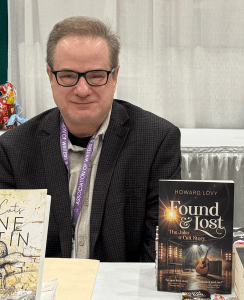 Howard Lovy is a veteran journalist, book editor, and author with 40 years of experience covering topics ranging from science and technology to Jewish issues. His work has appeared in Publishers Weekly, Longreads, The Jerusalem Post, and many more. A former executive editor of Foreword Reviews, he also hosts a podcast for the Alliance of Independent Authors. Howard lives in Northern Michigan with his wife, Heidi, and their dog, Henry. You can find him at https://howardlovy.com/
Howard Lovy is a veteran journalist, book editor, and author with 40 years of experience covering topics ranging from science and technology to Jewish issues. His work has appeared in Publishers Weekly, Longreads, The Jerusalem Post, and many more. A former executive editor of Foreword Reviews, he also hosts a podcast for the Alliance of Independent Authors. Howard lives in Northern Michigan with his wife, Heidi, and their dog, Henry. You can find him at https://howardlovy.com/
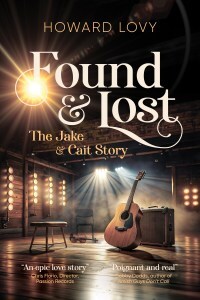 I was pleased to receive an advance copy of Howard Lovy’s debut novel, having enjoyed his podcasts and journalism, but I wasn’t sure what to expect – and this gentle, slow-burn romance surprised me in the best possible way.
I was pleased to receive an advance copy of Howard Lovy’s debut novel, having enjoyed his podcasts and journalism, but I wasn’t sure what to expect – and this gentle, slow-burn romance surprised me in the best possible way.
It’s a gentle, sensitive tale of youthful love forged by a shared musical talent, which ends in a sudden break-up unexplained until the end. Forty years later the revival of the couple’s music as a viral internet sensation – written long before viral social media posts were a thing – brings them back together in a storm of supportive publicity.
Although bound by an almost telepathic ability to play so well together, the young couple face other challenges brought about by their differences. She is a sincere Christian investigating different kinds of belief and he a Jew; she is a classically-trained, highly-educated musician, he is self-taught.
The unusual structure of the story is not only divided by two timelines decades apart, but also by the interspersal of transcripts of a TV documentary delving into their past as they reunite after 40 years apart. The insights into the music industry, past and present, and the occasional appearance of real-life musicians and producers such as the great Suzanne Vega add further depth and interest to this rewarding novel.
Highly recommended to anyone who enjoys clean romance reuniting past lovers, or who likes intelligent and original feel-good fiction.
HOW TO ORDER HOWARD’S NOVELFound & Lost: The Jake & Cait Story can be purchased through Vine Leaves Press here or on Amazon here.
May 17, 2025
Catching Up with My Blog
(Please note: This post replaces an earlier version that was somehow jumbled in the transmission – I’m hoping it will read in the right order this time!)
After emerging from a frantic period of activity, I’m just trying to catch up with myself, and have realized to my horror that I haven’t posted on my blog here since 8th April. So today I’ve decided to do a bit of catching up before it all gets completely out of hand.
First off, as a matter of record, I need to share the article I wrote for last month’s Tetbury Advertiser. As regular readers will know, each month I write two columns for local magazines, the Tetbury Advertiser and the Hawkesbury Parish News. This is something I’ve been doing since January 2010, when I first gave up my day job to focus on my writing. Then, every five years, I gather them all together and turn them into books, to save them for posterity. (Not that posterity will necessarily be interested, but rather that than treat them like tomorrow’s fish-and-chip papers!)
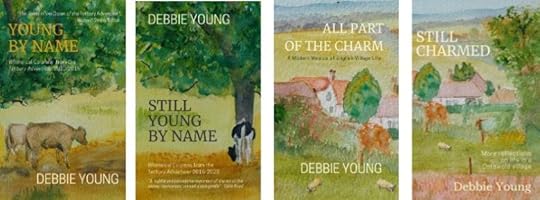 Watercolour paintings on the covers are by my father
Watercolour paintings on the covers are by my fatherSo far, there have been four volumes, each with five years’ worth of columns. “Young by Name” is the name of column in the Tetbury Advertiser, hence the name of the two books on the left. There’s no particular name for my slot in the Hawkesbury Parish News, but as you will have guessed, the two on the right gatther together those columns. Also, All Part of the Charm is prefaced by a collection of essays I wrote about village life, when I first moved to the Cotswold village of Hawkesbury Upton in 1991.
At the end of 2025, it’ll be time for me to round up the last five years’ worth of columns and create a third volume in each series. I’ve been talking recently to the students on the course I teach for Jericho Writers about the challenges of “naming conventions” for series of books. Once you start down a particular theme, you really have to stick with it to make it clear to the reader that the books are part of a set. If you have any brainwaves about what the titles should be for each of the new books, please let me know!
Which titles should I use for Round 3? Not As Young As I Used To Be? Can’t argue with that! Forever Charmed? Or is that just because the Alphaville song, “Forever Young”, is currently going round in my head?
These diverting additions to your bedside table, guest room or even your smallest room are all available to buy as . (They’re also in Kindle Unlimited, so if you are a subscriber already, you can effectively read them free of charge.)Anyway, as you were… what I really came here for was to add last month’s column from the Tetbury Advertiser, written during a cold snap which seems like ancient history now that we’re blessed with a bit of May sunshine.
I hope to get back on track with my weekly posts very soon…
A Chilly Perspective(first published in the April 2025 edition of the Tetbury Advertiser )
An informal survey about seasonal reading told me that not everyone reads festive stories at Christmas. Some people read them to cool down on hot days. Conversely, they use tropical stories to warm them up midwinter.
There again, I’m currently reading books set in places so cold they make our chilly spring days seem balmy. The Conquest of Everest is by John Hunt, leader of the 1953 expedition in which Edmund Hilary and Tenzing Sherpa were the first people to reach its summit.
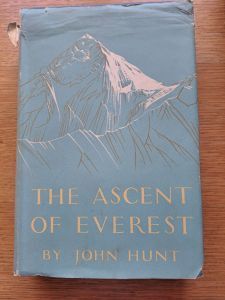 Cool reading
Cool readingCoronation Everest is by Times journalist Jan Morris (then James Morris), the expedition’s official reporter.
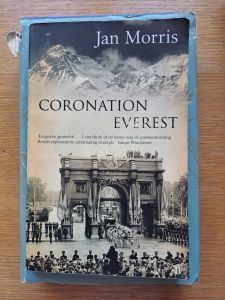 A double celebration
A double celebration‘Climbing Everest was largely a matter of logistics,’ writes Morris in Coronation Everest, with classic British understatement.
What logistics they were! Local porters carried huge loads as the party ascended from camp to camp. Hunt’s mountaineers also bore packs of as much as 60lbs each. Hardy Sherpas, acclimatized to physical exercise in the thin mountain air, carried even greater weights.
Hunt’s team took not only mountaineering equipment and camping gear for sub-zero high altitudes, but also photographic and scientific equipment for studies along the way.
James Morris carried the tools of his trade: typewriter, paper, and carbon paper.
To maintain their energy, they also had to carry vast amounts of food and drink. With scrambled eggs their breakfast staple, I was impressed that they seemed not to break their many dozens of eggs along the way.
Then I realised that in 1953, fresh eggs were still on ration. Powdered egg must have been a more easily portable alternative.
These days, as we go about our normal lives, we rarely need to carry very much very far. The heaviest loads I ever shift are bags of groceries, and then only from supermarket trolley to car boot, and from car boot to kitchen.
I’m embarrassed to remember feeling aggrieved as a child when my car-less mum expected my brother, my sister, and me to help carry the shopping bags home from the supermarket. Our arduous journey? A mere half mile from Blackfen’s Safeway supermarket. Knowing what I know now, if I’d been my mum, I’d have used the Everest team’s experience to put my complaints into perspective.
‘Be grateful,’ I’d say, ‘that you’re doing this on flat pavement at sea level, rather than across precarious ladders bridging crevasses above Everest’s “Death Zone”, which lacks sufficient oxygen to sustain human life for long.’
Reading books like this, the chilly English spring seems a feeble reason to replace my own supermarket missions with home deliveries.
But I draw the line at eating powdered egg.
April 8, 2025
Why There’s No I in Theatre
Anyone who has ever worked for their living or played team sport will probably have been told at some point: “There is no I in team.” Writing my first murder mystery play, The Importance of Being Murdered, caused a variation on that theme pop into my head: “There’s no I in theatre”.
Even before the first rehearsal, I recognised the importance of script editors in fine-tuning my original words. Thank you, Fiona Webb and Kirsty Stephen, for applying your wisdom and experience of live theatre to polish my play.
 Then at Hawkesbury Drama Group’s first readthrough, I was impressed by how much each actor added to my words, from an unexpected regional accent to comically eccentric pronunciation. When I first laughed aloud at their delivery, I tried to hold back because it’s bad manners to laugh at your own jokes. Then I realised these were no longer my jokes. They were shared with the cast whose interpretations were adding colour to the words I’d written.
Then at Hawkesbury Drama Group’s first readthrough, I was impressed by how much each actor added to my words, from an unexpected regional accent to comically eccentric pronunciation. When I first laughed aloud at their delivery, I tried to hold back because it’s bad manners to laugh at your own jokes. Then I realised these were no longer my jokes. They were shared with the cast whose interpretations were adding colour to the words I’d written.
At this point, the cast were all still sitting down, reading from scripts. Further nuance will be added when they’ve learned their lines and blocked the moves, adding gesture and body language.
By the time the play is performed, more layers of interest will have been added by the production team, including wardrobe, set designers, and tech.
No actor, no matter how brilliant, can carry off a show without such a team of experts behind the scenes.
Not even the brilliant Andrew Scott in his one-man show Vanya, (his own adaptation of Chekov’s Uncle Vanya), would have gained as much acclaim without the hard work and specialist skills of the invisible forces in the wings and elsewhere. (By the way, Vanya is available to watch now on National Theatre Live, and I highly recommend this absolute tour-de-force by Scott.)
When watching the closing credits of films, I’ve often marvelled at the number of people involved in their production. Many of the job titles listed mean nothing to me. Best boys? Sounds like child labour to me – Victorian child chimney sweeps spring to mind. Gaffers? Is their sole duty to look after the film’s stock of gaffer tape? Grip? Whatever he does, it must be important never to lose him.
Thankfully, theatre credits are usually easier to understand. Next time I’m at a play, whether in Hawkesbury or elsewhere, I’ll be sure to read the fine detail of the programme to acknowledge the contribution of everyone involved in the production, on stage and off.
Meanwhile, break a leg, Hawkesbury Drama Group – I’m looking forward to enjoying our show!
Tickets now available from hawkesburydrama@gmail.com – and they’re going fast, so book now to avoid disappointment!
This post was first published in the April 2025 issue of the Hawkesbury Parish News.
IN OTHER NEWSLast week, I sent the manuscript for my next novel to Rachel, editorial director at my publisher Boldwood Books, which meant I had a few days’ respite to work on other things before her suggested edits landed in my inbox demanding my attention.
Mostly I’ve been working on event planning for two local public events:
the Badminton Benefice Festival of Music, which will bring a delightful series of free musical events to our local parish churches this summer and autumnthe next Hawkesbury Upton Literature Festival event, which will take place at our local parish church on Saturday 27th SeptemberI’ll share more information about both of those events here, and the websites will be updated, as our plans are confirmed.
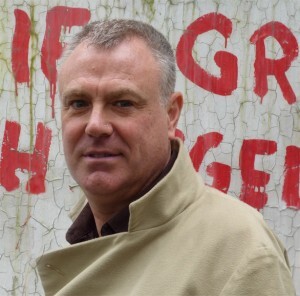 Meet Stephen Oram in Bristol on Monday 14th April at Bookhaus
Meet Stephen Oram in Bristol on Monday 14th April at BookhausIn the meantime, I’m looking forward to going to an author event simply as a member of the audience – much more relaxing! Congratulations to author Stephen Oram, who will be launching his latest speculative near-future sci-finovel, We Are Not Anonymous, on Monday 14th April at 6pm at Bookhaus, Bristol. Stephen is based in Fitzrovia, London, and I’ve been following his writing career since the outset. He was a very popular guest speaker at last September’s Hawkesbury Upton Lit Fest, so I’m delighted that he’s heading in our direction again for his next event.
If you’re in striking distance of Bristol and love intelligent, wry sci-fi inspired by modern technological and societal trends, come and join us!
March 26, 2025
In Conversation with Linda Alvis – Artist, Author & Poet
As regular readers of my blog will know, my final post each month is a conversation with an author friend, talking about their creative process and other topics that I hope you will find of interest. This month, it’s perfect timing to welcome Linda Alvis to celebrate the launch of her latest travel memoir, the third volume in her series Hoovering Up the Holy Carpet.
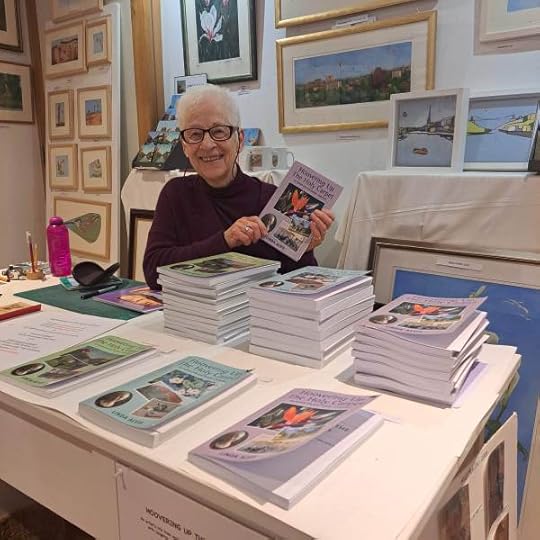 Linda Alvis in her studio at her latest book launch
Linda Alvis in her studio at her latest book launchDebbie: You’re best known as an artist rather than an author. Please can you tell us a little bit about your background and your achievements as an artist.
Linda: I have written little poems and stories since early childhood as well as painting and drawing. My first memory of drawing is at Bristol Museum when I was four years old. Later I had a small den in the roof of my home where I wrote stories and poems. I have only one poem from that time and it is very over romantic and rather ‘Wordsworthy or Byronesque’. It isn’t in my poetry book!
I have won an award for one of my paintings and two works have been exhibited at The Mall Galleries in London. One with The Pastel Society and the other with The Society of Women Artists at their Annual Open Exhibitions. Over the years I have had many commissions.
Debbie: What made you decide to start writing books?
Linda: I always loved writing essays at school but it wasn’t until I broke my right wrist very badly in 2007 that I started a ‘pamphlet’ for my art class, using the computer and my left hand. I couldn’t use my right hand for many months. I got so carried away with family history and my journey as an artist that, when I found I had written ten computer pages and was still in the 1940’s, I decided to carry on.
Debbie: This month, you’ve launched the third in your series of entertaining travel memoirs. How do those relate to your art?
Linda: From the age of 6 or 7 I was sent off to the Saturday mornings children’s cinema by my busy shopkeeping parents and loved the black and white films shown then. ‘Cowboys and Indians’, Roy Rogers and Hopalong Cassidy etc., as well as Heidi with Shirley Temple and other cultural offerings. I was especially hooked on anything relating to the indigenous peoples of North America. Having friends and relations in Australia, Canada and the USA I have been able to meet with many indigenous peoples who have been gracious enough to allow me to photograph them and paint their portraits.
Debbie: On just about every trip, you tap into local art and culture of the indigenous people. What are your most memorable encounters of this kind?
Linda: My meeting with Tanya Nungari in the Alice Springs area. She and her husband were just sitting in the shade under a tree near an aboriginal centre. Tanya was an aboriginal naive artist and I was able to purchase a painting that she was carrying. I wanted to talk more to her but very suddenly she and her husband Wesley just ambled off into the bush. However she had allowed me to photograph them for a future portrait.
My mother and I were privileged to visit Vietnam in 1993 as part of the first group, rather than single travellers, to enter since the American war. It was led by the late great Tony Soper. It was amazing, experiencing Vietnam on the cusp of change.
Another most memorable was with Aaron Lee, a Cree artist and leather/bead worker in Edmonton, Canada. He had an incredibly strong face and I just had to ask if I could take a photograph of him for a portrait and he replied ‘Do you want me to look dangerous?’ We both laughed. He used the eventual portrait on his website which was an honour.
My portraits of Ukrainian people are the most poignant, ’The Bandoura Player’ in Kiev, The Cossack boy and Ivan Petriovich, the retired hydroelectric power engineer in Zaporozhya, a Dancing girl in Novaya Kakhovka and the beautiful Lilya in Sevastopol.
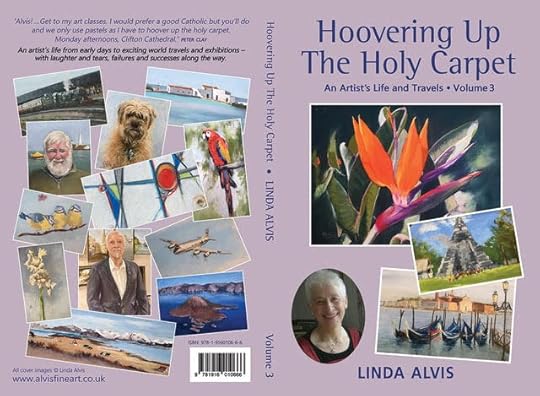 Linda shares a taster of her art on the covers of each of her travel memoirs
Linda shares a taster of her art on the covers of each of her travel memoirsDebbie: Your trilogy of travel memoirs has a surprising title: Hoovering Up the Holy Carpet. How did that come about?
Linda: I was in the RWA in Bristol, looking at various works of art when a voice boomed across the gallery:
Alvis, get to my art class. I would prefer a good Catholic, but you’ll do! We only do pastels as I have to hoover up the holy carpet!
Monday afternoons in the Roman Catholic Cathedral. I feeI I have been hoovering up the holy carpet, so to speak, ever since.
My trilogy is for those who love family sagas, art and travel and hopefully will inspire readers to be brave in their endeavours, travel to wonderful places or just accompany me on the journey.
Debbie: I was astonished at how many countries you’d visited. If there are any countries left that you’d still like to visit, which are they and why?
Linda: Once I had an opportunity to go to Papua New Guinea, always a dream, but it didn’t happen and that is a regret. I love ‘off the beaten track adventures’ and was most fortunate to go outback camping on Aboriginal land in the Northern Territories of Australia. It was quite rugged but marvellous. I have been to Guatemala in Central America for a wedding but would love to see more of South America.
Debbie: Although this month we’re celebrating the launch of your third travel memoir, you have other books to your name. Can you please tell us a little bit about these too.
Linda: I first wrote my children’s books, Worrall and Robin and Worrall, Robin and the Garden Visitor after a memory that had been buzzing around in my head for years. When first married I was planting some flowers in the garden when I unearthed a very large colony of huge earthworms. I was so shocked I had sit down with a cup of tea. So, in the story, the large chief worm Worrall looks after his community and especially the naughty Jimmy Wriggle who is always getting into trouble with the Robin. Mainly for approximately 4-9 year olds, they are garden dramas with humour and a cautionary tale, with some new characters in the second story.
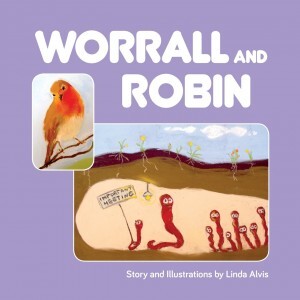
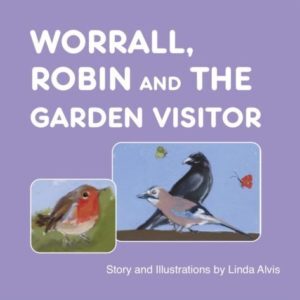
After the ‘Worrall’ books I decided to do something with my largish collection of poems so Dawn Rising came about. A series of life poems each accompanied by one of my paintings. I was asked to be part of the Poetry Slam at the Hawkesbury Upton Literary Festival back in 2017 and was thrilled to come joint first!
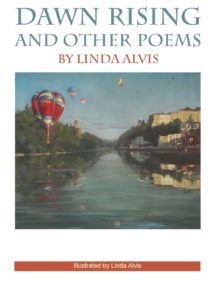
Debbie: What would be your advice to anyone else thinking of writing travel memoirs, eg should you keep a daily journey on your travels? Is it best to allow time to process your experiences before you write them up?
Linda: Yes, I do make notes, especially when travelling in places like India as I would never remember all the names of towns and villages I passed through and events witnessed there but as photography has always been one of my first and great loves I take many photographs for reference and make brief notes in situ. It is best to strike while the iron’s hot so you don’t forget anything.
Debbie: What are you working on at the moment?
Linda: Recovering from launching Volume Three of Hoovering Up The Holy Carpet but I now have ideas for a novel.
Debbie:A novel – that’s exciting! Keep me posted! Now, final question: you often host or take part in art events in your home city of Bristol. Are there any coming events that you’d like to tell us about today?
Linda: My partner and I always hold our own summer exhibition of art and, weather permitting, open up the gardens for visitors to sit awhile and enjoy the peace and colour. We are also always involved in the West Bristol Art Trail which is a huge event each mid-October and is extremely popular with visitors. My books are alway available at these events. Recently I was a guest speaker with two other authors at a lively and well-attended event at Clifton Library. Hopefully more opportunities like that in the future.
Linda has kindly allowed me to whet your appetite for her latest volume of travel memoirs with these two short extracts.
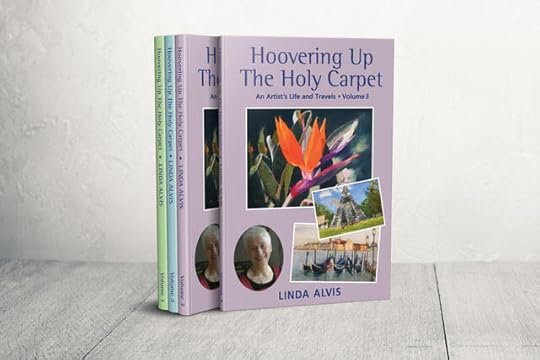
I had read about Melk in the cruise information pack but could have no idea of the true magnificence of this Abbey. We arrived at our mooring in the early morning and, as usual, I was up at the crack o’ dawn to have a short sprint around the deck when I was stopped by staff at the foyer desk.
‘Have a walk through the forest to see Melk. You can do it and be back for breakfast.’
Ooh, yes, I was definitely keen to do that and off I set. I found a path through the forest and passing a man jogging and lady walking her dog, neither over friendly, pressed on wondering if I was doing the sensible thing. It seemed a very long way to go. Eventually, with some relief, I saw daylight through the woods and as I arrived at a river in welcoming daylight I was stopped in my tracks. I gasped in absolute amazement as there above me, and appearing to fill the sky, was this immense and most spectacular Baroque abbey, perched above the town and gleaming gold against a clear blue sky. It quite took my breath away. Walking over a bridge into the town I passed a pure white heron searching for breakfast. I would soon have to return to the boat for my own breakfast but, walking through the quiet streets, the town was beginning to wake up. Men walked to work and
ladies with baskets headed for the market as the shutters of a small hotel were being opened as I passed by. I decided to have a quick coffee before the trek back to the boat and sit a while to take in the loveliness of that pure morning.
I approached the hotel desk and hoping my rusty school German would suffice asked … ‘Eine kleine kaffee bitte, mit melk.’ Praise be, I was understood. Sitting outside under an umbrella for shade, I was served a delicious coffee, beautifully presented on a silver tray and with a glass of water. I relished this heavenly moment before speeding back to the boat in time for breakfast. I would never forget the loveliness of that morning.
Arriving in Guatemala for a weddingAfter changing flights in very pleasant Dallas airport, I arrived at night, in sprawling Guatemala City, a forest of lights as we descended. Slightly overtired by this time, but trusting, I hoped the arranged transfer to Antigua would arrive. It did and, with four other guests from the USA, we travelled for an hour to our destination, the Hotel Porta. Slightly discombobulated by this time and longing for bed, I followed a porter to my lovely garden room. On the bed was a ‘welcome’ package’ containing Guatemalan liqueur, sweets and toiletries from Megan and Sergio. What a delightful touch. By that time it was midnight and I was so tired I had to get to bed. I decided I would catch up with the Harveys the next morning. I quickly fell fast asleep but was suddenly woken by the bed heaving backwards and forwards.
What was this? Had I been given the honeymoon suite? Dazed, my whole body jerked up and down and then, just as suddenly, it stopped and off to sleep I went again, thinking I would have a lie-in the next morning.
At much too early an hour, I was woken by loud squawkings from a family of macaws just outside my bedroom window. How strange, I thought, I expected to wake up much later but never mind, I’ll get off to breakfast and meet up with my friends. Outside my room was a shady corridor filled with exotic flowering plants, including a magnificent Strelitzia, and some species I had never seen before. The macaws had settled down by then and I walked across leafy grounds by a swimming pool to the semi-open dining room. Kelly and Rodger, parents of the bride, were already there and we hugged each other quite emotionally. How lovely to see them again and on such an occasion.
‘How did you cope with the earthquake?’ Kelly asked.
I told her about the bed at midnight.
‘No, the big earthquake this morning. Well over 5 on the Richter scale!’
Goodness, I had slept through it. No wonder the macaws were disturbed.
For more information about Linda’s work, and to view her beautiful artwork, visit her website: www.alvisfineart.co.uk.
All Linda’s books are available from Amazon.
Click here to view the Amazon page for her travel memoir trilogy, Hoovering Up the Holy Carpet.
View Linda’s gallery of art, including many pieces inspired by her travels, here.
View Linda’s completed commissions here.
IN OTHER NEWS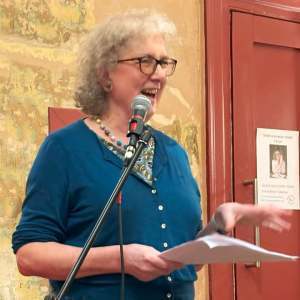 (Photo by Félice Hardy)
(Photo by Félice Hardy)As you can tell from Félice Hardy’s photo of me in action, I had great fun last week as a guest speaker for the Frome Writers’ Collective, talking about different paths to publication. Tickets sold out in advance, and when I arrived at the venue – the gorgeous and historic Archangel Hotel in Frome – I was slightly startled to see posters just about everywhere advertising my appearance!
The room was jam-packed with enthusiastic writers at all stages of their careers, many of whom had great questions at the end.
 Huge thanks to Félice for inviting me. I first met Félice when she offered to speak at my Hawkesbury Upton Literature Festival about quite a different kind of memoir to Linda’s – a family history called The Tennis Champion Who Escaped the Nazis. The book is as compelling as that extraordinary title suggests, and if you’ve not yet read it, I highly recommend it.
Huge thanks to Félice for inviting me. I first met Félice when she offered to speak at my Hawkesbury Upton Literature Festival about quite a different kind of memoir to Linda’s – a family history called The Tennis Champion Who Escaped the Nazis. The book is as compelling as that extraordinary title suggests, and if you’ve not yet read it, I highly recommend it.
Now, after a short break visiting my daughter in Aberystwyth, I’ll be glued to my desk for the rest of the month, completing my next book Death at the Village Christmas Bazaar (working title), due to launch on 4th September 2025 – you can already pre-order it here.
March 14, 2025
A Portrait of Hope
In this month’s Hawkesbury Parish News, I’m celebrating the wealth of talent resident in our Cotswold village, and in particular artist James Nickells and his Global Portrait Project.
What is it that makes the residents of Hawkesbury so talented? Is there a secret ingredient in the local water that sparks creativity and talent?
Or perhaps there’s something about the parish that encourages those with special gifts and skills to move here. The general acceptance of exception and difference in our community is one of the many things that makes it a special place to raise our children and for individuals to thrive.
The latest manifestation of local talent is James Nickells’ recent exhibition at Three Storeys, Nailsworth of the first fifty portraits in his Global Portrait Project. This is his personal quest to paint a portrait of somebody from every country in the world. Going by the United Nations Sovereign States list, he has committed to producing 193 paintings.
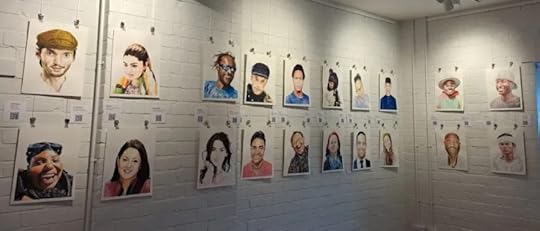
His methodical approach of working through the list of countries in alphabetical order – at the time of the exhibition, he’d just reached the Dominican Republic – may come from the rigorous training and discipline of his day job as an anaesthetist – or from his other hobby as a champion solver of jigsaw puzzles!
He’s not painting just anyone from each country. As he explains on his website,
The sitter will be selected based on them having a positive story of how they have made an impact on an environmental issue. Some stories will be about individual change. Some will be about improving an environmental problem in their communities.
Working from photographs, James paints in ink, which, in his hands, creates a startlingly lifelike image of his subject with extraordinary attention to detail. The hair, the eyes, the skin, the glasses, and much more, all reward close scrutiny.

A time-lapse film shows James at work on the first portrait from the project.
It’s not just the calibre of his artwork that inspires, but the stories behind each picture. Seeing the first fifty portraits of amazing role models making a positive impact on our planet was extraordinarily uplifting.
This was a particularly welcome feeling when there is so much dispiriting and downright frightening news around the world just now, and not only to do with the environment.
Disappointed that you’ve missed the exhibition?
Don’t worry, you can catch up and keep up with the Global Portrait Project via James’s YouTube channel here: https://www.youtube.com/@theglobalportraitproject4628. Here James shares time-lapse photography of each portrait in progress, prefaced by the story of the subject’s work.
You can also follow James’s journey via his project website, www.globalportrait.com, on Instagram at @globalportraitproject.
Every follow encourages James and helps spread the word about his remarkable Global Portrait Project – yet another reason we can be proud of the talent resident in our parish.
This article first appeared in the March 2025 Hawkesbury Parish News.
IN OTHER NEWSThird Cotswold Curiosity Shop Mystery Now Available to Pre-orderIf you’ve been enjoying the first two books in my new Cotswold Curiosity Shop series, Death at the Old Curiosity Shop and Death at the Village Chess Club, you’ll be pleased to know that the launch date has been announced for the third in the series. Death at the Village Christmas Bazaar (working title) will be published on Thursday 4th September. The ebook is already available to pre-order on Amazon here. As with all my Boldwood Books titles, it will also be published in paperback, hardback and audiobook.
In the meantime, the first two books in the series are selling well and also attracting plenty of enthusiastic reviews. Huge thanks to all my readers for your support. Every sale and every review drives me on to write more books
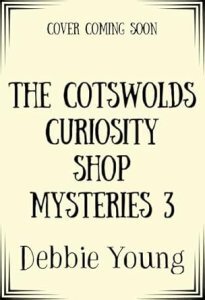 Launching on 4th September 2025Tickets Now on Sale for My New Murder Mystery Play
Launching on 4th September 2025Tickets Now on Sale for My New Murder Mystery PlayTickets are also selling well for my new murder mystery play, The Importance of Being Murdered, which will be presented by Hawkesbury Drama Group (more local talent!) on 25th and 26th April. The audience are invited to play detective and solve the murder at the end of the show. There will be different endings each night, so that there can be no spoilers for the second audience! The ticket price include antipasti snacks at the first performance, and a two-course meal the second night, provided by village caterers Poppy and Boo (yes, even more local talent!) A pay bar will be open too. Tickets are available in tables of eight or individually, and must be booked in advance, as we anticipate a sell-out both nights. To book your tickets, simple email hawkesburydrama@gmail.com. 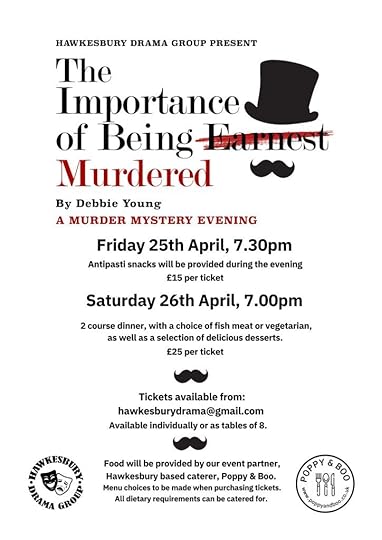
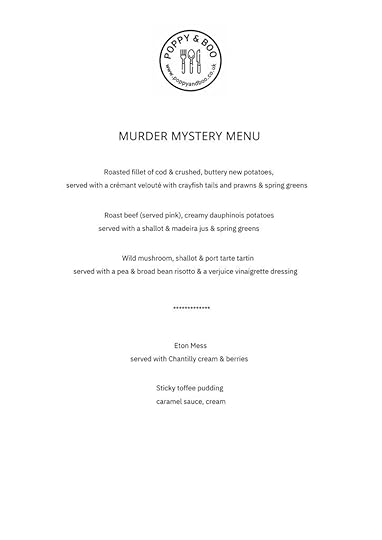
March 7, 2025
The Fascination of Secondhand Books
Despite my house already being full of books, with multiple shelves in every room, I can never resist the draw of secondhand books, whether from a dedicated seller of used books or from a charity shop. Whenever I go on holiday, whether for a long or short break, there seems to be an unwritten rule that I must return with at least one book for every day spent away from home.
My recent trip to visit my aunt in London resulted in a five-book haul from charity shops, plus one volume purchased from a purveyor of new books, to salve my conscience for buying so many secondhand. It’s important to support independent booksellers too. (That’s my excuse, anyway.)
My new purchase from Wimbledon Books was an illustrated version of H G Wells’ The Invisible Man. Only as I write this does that strike me as an amusing contradiction in terms. No, the illustrations weren’t just blank pages.
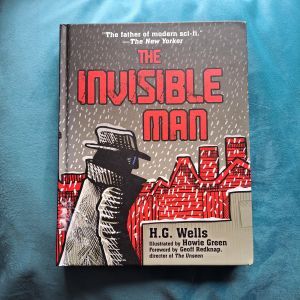 Now you see him…
Now you see him…Since arriving home two days ago, I’ve already finished reading one of my new acquisitions: The End of the Affair, one of the few Graham Greenes that I hadn’t read before. Discovered in the ‘five books for a pound’ basket in Wimbledon Village’s British Red Cross shop, the edition didn’t match the old orange-spined Penguin paperbacks that make up the bulk of my Greene collection.

The only exception is a beautiful Folio edition of Travels with My Aunt, one of my favourite books of all time.
Despite my penchant for matching sets of books, three features persuaded me to buy it:
First, it was a vintage hardback from 1960 (the same vintage as me, in fact), and I love vintage hardbacks.
Second, a small green sticker on the inside cover showed it was originally sold by Dymock’s, the Australian bookshop chain. I couldn’t help wondering about the little book’s journey from Sydney to south London.
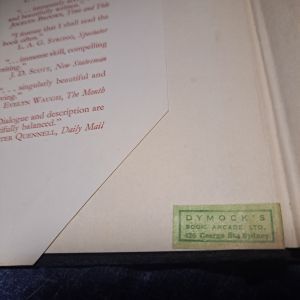
Third, pencil markings in the margins – usually a turn-off because I find them a distraction – intrigued me by being written in what I think is Chinese. These were translations of English words unfamiliar to the Chinese reader, such as ‘maliciously’, ‘pervert’, and ‘mortification’ (bless him!)
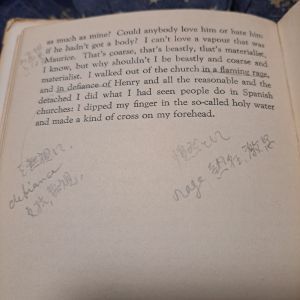 I think these are in Chinese – but you know different, please tell me!
I think these are in Chinese – but you know different, please tell me!When reading the novel I discovered a fourth unexpected charm. Towards the end comes a passage describing a key character’s collection of books. One of these is Scott’s Last Expedition, the diaries from the polar explorer’s ill-fated trek towards the South Pole.
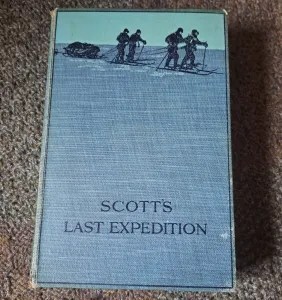
Why did this startle me? One of the other four second-hand books I bought on this trip was Scott’s Last Expedition – a beautiful hardback, possibly even the same early edition referred to in Greene’s novel. When his narrator goes on to discuss at length the nature of coincidence, I was positively spooked.
All in all, I’m glad I splashed out in the British Red Cross shop that day – and that, unable to find four other books in the “five for a pound” basket that I wanted, I insisted on paying a pound for this one book. I’ve certainly had my money’s worth.
This post first appeared in the March 2025 edition of the Tetbury Advertiser.
IN OTHER NEWSLatest Novel is a Bestseller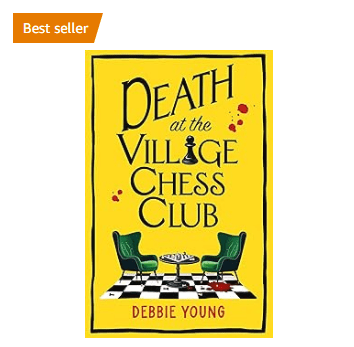 Last Monday, 3rd March saw the publication of my latest novel, Death at the Village Chess Club, the second in my Cotswold Curiosity Shop series and the sequel to Death at the Old Curiosity Shop.
Last Monday, 3rd March saw the publication of my latest novel, Death at the Village Chess Club, the second in my Cotswold Curiosity Shop series and the sequel to Death at the Old Curiosity Shop.
I’m thrilled to report that on the day of its launch, and subsequently, it has been flying the distinctive orange bestseller flag on Amazon’s UK store, reading #69 in the whole of the UK store, and #1 in the rather oddly named Cosy Crafts and Hobbies Mysteries category!
My publisher Boldwood Books sent it on a blog tour, run by Rachel’s Random Resources, which means that several bloggers a day have been sharing their reviews online, whether on their blogs, on Amazon, on social media, or on Goodreads. I’ll share the schedule below in case you would like to look any of them up.
I’ve been very touched by all the kind comments, including the following extract, which suggests I’m achieving exactly what I set out to do with this book:
“The story is compelling and exciting, with plenty of twists and turns. But I still get the cosy village feel -along with a hint of romance. Ultimately it’s the warmth and community feel that makes this story a touch above the rest for me. An addictive mystery with heart.” (Kitty Kat, book blogger and on Amazon)Huge thanks to Kitty Kat, to all the bloggers on the tour, and to all who have read my new book so far, whether or not they choose to review it (although good reviews are always very welcome!)
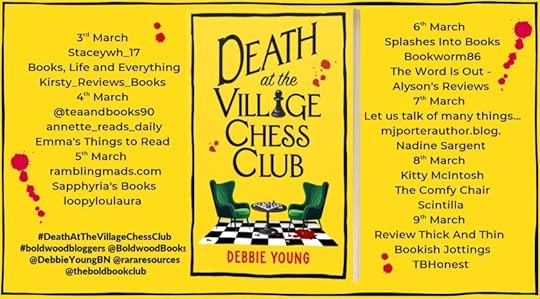 Tickets On Sale for My New Play
Tickets On Sale for My New PlayWith rehearsals well under way for my first stage play, The Importance of Being Murdered, tickets are now on sale. Hawkesbury Drama Group is expecting to sell out on both nights, so book early to avoid disappointment! See images below for details of how to book and of the menus to be served at each performance.
The play is about an amateur theatrical group in the village of Bunbury preparing to stage a production of Oscar Wilde‘s The Importance of Being Earnest. Their plans are disrupted when a retired star of stage and screen moves the village, demanding a leading role, with deadly consequences…
Each night the audience is invited to play sleuth to solve the murder mystery. There will be a different killer in each performance, at the request of Hawkesbury Drama Group, so that they can run the show for two nights without any plot spoilers for the audience at the second performance!
The venue is Hawkesbury Village Hall, just off the Cotswold Way. Read more about its facilities and how to find it here.



